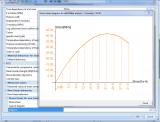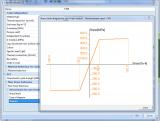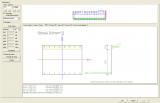Highlights
- Physically and geometrically non-linear analysis of concrete structures.
- The effect of cracks, plasticity and other factors on the stiffness taken into account.
- Iteration and secant Newton-Raphson method applied.
This module is suitable for the analysis of the redistribution of internal forces due to the physical non-linear behaviour of (reinforced) concrete or masonry structures in combination with non-linear conditions and geometrical non-linearity.

This module takes account of the physical non-linear stiffness of concrete, so that the user is able to model concrete structures as close to reality as possible and thus find the most economical design. The analysis process may include other types of non-linearity such as geometrical.
User can define physically non-linear stress-strain diagrams for individual concrete grades, reinforcements or masonry materials - for all the codes available in SCIA Engineer. He or she can define such diagrams as parabolic, bi-linear (linear- constant) or polygonal and can derive them from the stress-strain relationship defined by a national code or specify them themselves.

SCIA Engineer uses this stress-strain diagram to calculate non-linear axial and bending stiffness values around the local y- and z-axes. The cross-section can contain various concrete grades, can be of any shape, and can include reinforcement or not. This means that users can make advance concrete calculations for such items as columns, continuous beams, and tunnels subject to soil loads.


As this module is also suitable for parametrised structures, the user can generate several typical structure templates in the quest for the most economical design: a lattice girder slab manufacturer might want to have as much above-support reinforcement as possible; a construction company might prefer to have the least amount of above support reinforcement as possible. The codes allow for some redistribution of internal forces resulting from the physical non-linear behaviour of concrete, so the user is in a position to recommend the most economical design for any particular client.
User can apply such physically and geometrically non-linear calculations to both two- and three-dimensional frame structures. If the model for the structure under analysis contains also plates (or more generally shells), the program considers the plates or shells as linear elements. The same approach is applicable to beams made of material other than reinforced concrete.
The program takes into account the effect of cracks, plasticity and other factors on reinforced concrete beam stiffness. The user can select which non-linearity system to use. It could be
- physical,
- geometrical,
- both.

The results for each calculation clearly show the cracked cross-section and the calculated axial and bending stiffness for each cross-section. The user can check each cross-section individually using the single check dialogue format, displaying the applied loads and resulting stresses and strains in the (reinforced) cross-section.
The program can send all of these results to documentation and produce neat and insightful calculation output.




Required modules:
- sen.00

Want to try SCIA Engineer yourself?
Explore how our software and services can help you optimise your work and boost your productivity. Try it for yourself with a free 30-day software trial.
Download a free 30-days full trial